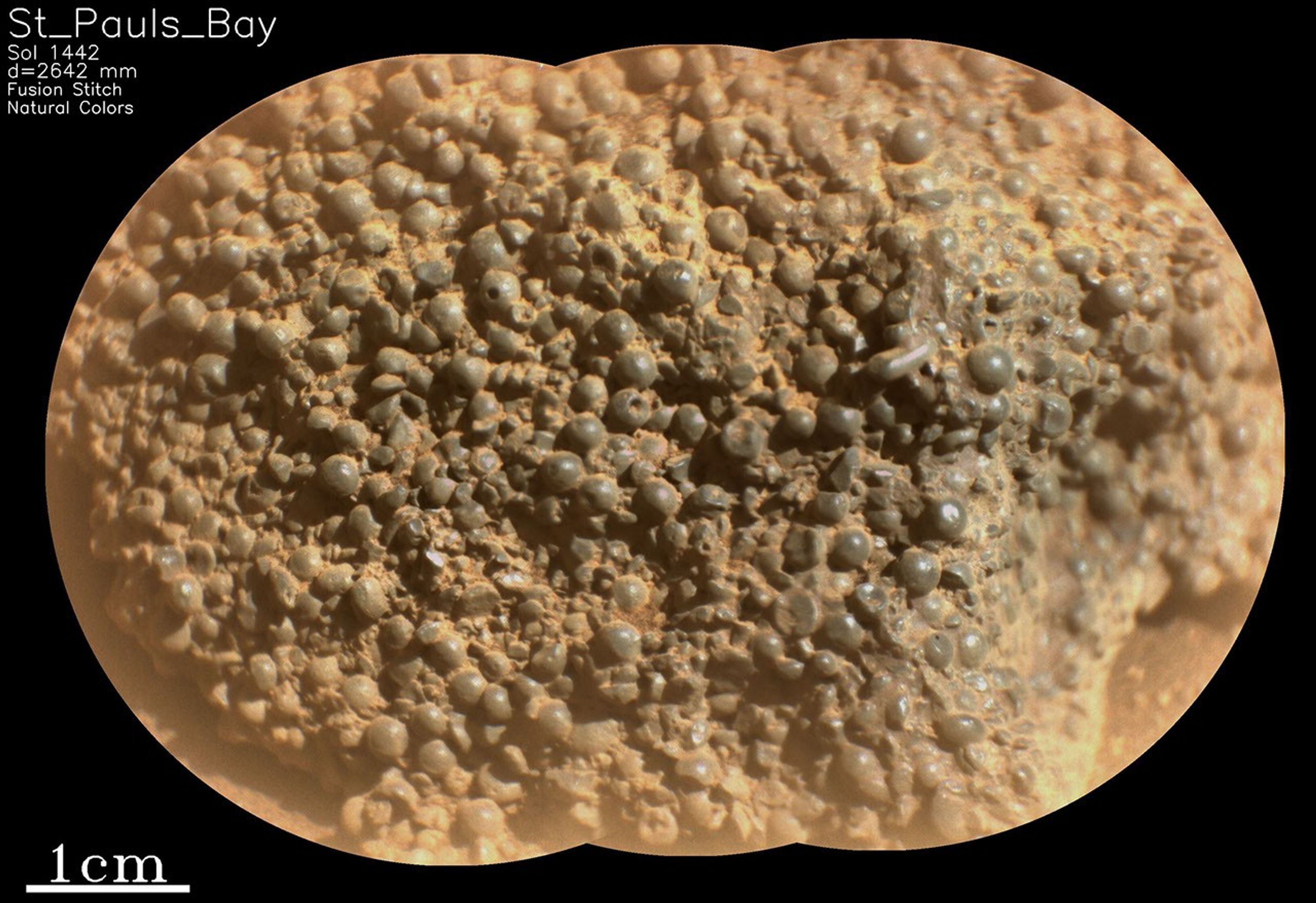3 min read
Shocking Spherules!Written by Alex Jones, Ph.D. candidate at Imperial College London
Last week the Perseverance Science Team were astonished by a strange rock comprised of hundreds of millimeter-sized spheres… and the team are now working hard to understand their origin.
This image from NASA’s Mars Perseverance rover, a fusion-processed SuperCam Remote Micro Imager (RMI) mosaic, shows part of the “St. Pauls Bay” target, acquired from the lower Witch Hazel Hill area of the Jezero crater rim. The image reveals hundreds of strange, spherical-shaped objects comprising the rock. Perseverance acquired this image on March 11, 2025, or sol 1442 — Martian day 1,442 of the Mars 2020 mission. NASA/JPL-Caltech/LANL/CNES/IRAP.It has now been two weeks since Perseverance arrived at Broom Point, situated at the lower slopes of the Witch Hazel Hill area, on the Jezero crater rim. Here, a series of light- and dark- toned bands were visible from orbit, and just last week the rover successfully abraded and sampled one of the light-toned beds. It was from this sampling workspace where Perseverance spied a very strange texture in a nearby rock…
The rock, named “St. Pauls Bay” by the team, appeared to be comprised of hundreds of millimeter-sized, dark gray spheres. Some of these occurred as more elongate, elliptical shapes, while others possessed angular edges, perhaps representing broken spherule fragments. Some spheres even possessed tiny pinholes! What quirk of geology could produce these strange shapes?
This isn’t the first time strange spheres have been spotted on Mars. In 2004, the Mars Exploration Rover Opportunity spotted so-called, “Martian Blueberries” at Meridiani Planum, and since then, the Curiosity rover has observed spherules in the rocks of Yellowknife Bay at Gale crater. Just a few months ago, Perseverance itself also spied popcorn-like textures in sedimentary rocks exposed in the Jezero crater inlet channel, Neretva Vallis. In each of these cases, the spherules were interpreted as concretions, features that formed by interaction with groundwater circulating through pore spaces in the rock. Not all spherules form this way, however. They also form on Earth by rapid cooling of molten rock droplets formed in a volcanic eruption, for instance, or by the condensation of rock vaporized by a meteorite impact.
NASA’s Mars Perseverance rover acquired this image of the “St. Pauls Bay” target (the dark-toned float block in the right of the view) using its Left Mastcam-Z camera, one of a pair of cameras located high on the rover’s remote-sensing mast. Perseverance acquired this image on March 13, 2025 — sol 1444, or Martian day 1,444 of the Mars 2020 mission — at the local mean solar time of 11:57:49. NASA/JPL-Caltech/ASUEach of these formation mechanisms would have vastly different implications for the evolution of these rocks, so the team is working hard to determine their context and origin. St. Pauls Bay, however, was float rock — a term used by geologists to describe something that is not in-place. The team are now working to link the spherule-rich texture observed at St. Pauls Bay to the wider stratigraphy at Witch Hazel Hill, and initial observations have provided tantalizing indications that it could be linked to one of the dark-toned layers identified by the team from orbit. Placing these features in geologic context will be critical for understanding their origin, and determining their significance for the geological history of the Jezero crater rim and beyond!
Share
Details
Last Updated Mar 21, 2025Related Terms
BlogsExplore More
4 min readSols 4484-4485: Remote Sensing on a Monday
Article 1 day ago2 min read
Sols 4481-4483: Humber Pie
Article 3 days ago3 min read
Sols 4479-4480: What IS That Lumpy, Bumpy Rock?
Article 1 week agoKeep Exploring
Discover More Topics From NASA
Mars
Mars is the fourth planet from the Sun, and the seventh largest. It’s the only planet we know of inhabited…
All Mars Resources
Explore this collection of Mars images, videos, resources, PDFs, and toolkits. Discover valuable content designed to inform, educate, and inspire,…
Rover Basics
Each robotic explorer sent to the Red Planet has its own unique capabilities driven by science. Many attributes of a…
Mars Exploration: Science Goals
The key to understanding the past, present or future potential for life on Mars can be found in NASA’s four…
Read More Details
Finally We wish PressBee provided you with enough information of ( Shocking Spherules! )
Also on site :
- Watch Live: American Cardinal Robert Provost chosen as new pope
- White smoke appears over Sistine Chapel as Conclave elects new Pope
- New Pope elected

